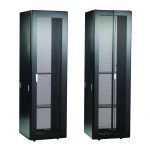We are often asked for assistance to help select a 19” Network Cabinet Rack. Before we get to the tips, let’s just define what a 19” Network Cabinet Rack is. Typically, these racks are used for mounting 19” equipment such as hubs, switches, routers, bridges, gateways, multiplexers, transceivers, firewalls and servers. The components will either have mounting ears to directly mount within the cabinet (see more below) or will be placed on shelves within the rack. The purpose of these racks is to protect the equipment by securely storing them by getting them up off of the floor and often consolidating them in many layers. There are many types of network cabinet racks and we will not address them specifically in this blog but will rather focus on some of the basics.
SIZE DOES MATTER IN SELECTING YOUR NETWORK CABINET RACK
There are a few key dimensions to keep in mind when you are specifying your network rack.
The first is panel height. This is different than the overall height as it is the clear space into which you can mount your components. It is basically the height of the opening within the rack. It is important to add up the height of the items you are looking to mount to be sure they will all readily fit. Don’t forget to include any air ventilation space you may need between components. That does not mean that overall height is not important. We have had customers who order a large rack only to find that the ceiling in the room they are using is not high enough. Finally, be sure there is enough depth space for your deepest components.

This network cabinet rack offers maximum ventilation
WHAT IS YOUR APPROACH FOR MOUNTING YOUR COMPONENTS IN YOUR NETWORK CABINET?
All network cabinet racks come with panel mounting rails. These are long relatively thin pieces of formed metal that are used in pairs to mount the mounting ears of your component into the rack. They will typically be pre-drilled on EIA spacing. EIA spacing is the industry standard that goes back to the early days of telephony well over 100 years ago. The holes on your equipment and on the panel mounting rails will be set on this standard which is based on the space between holes of 5/8”, 5/8”, ½” which will total 1-3/4” This dimension is known as a “u” for unit and racks are often specified as multiples of the “u” or 1-3/4”. A typical dimension for a networking cabinet rack is 45u (77”) or 46u (78.75”). You will also need to determine if you need two pairs of mounting rails or just one depending on the mounting provisions of your components and their weight.
WHERE ARE YOU GOING TO PUT THE NETWORK CABINET RACK?
The location of your racks is an important decision factor in selecting the proper rack. If it is going in a closet, as if often the case, your concerns are much more basic than if it is going in an open space. If it is a closet, a simple cabinet rack will do as you already gain the protection of the closet itself. You may even decide to go with a smaller wall mounting unit which is very popular for these applications especially if the components are lightweight. If it is going to be in the middle of an office, you will want to focus on ensuring that it looks professional and protects the components from curious people.
DO YOU NEED VENTILATION OR OTHER FEATURES?
There are many ways to ensure that the components you are mounting have the proper level of cooling so they do not overheat. It could be as simple as not needing a front or rear door on the cabinet or ensuring that the sides or tops or doors or all of the above have ventilation holes or slots included. Other questions that might be considered include whether unique cable access is required so that the proper access points are included. Also, what are the access concerns for repair? Often, the ability to easily remove sides or doors can allow quick repairs or adjustments without having to uninstall the components.
DO YOU NEED ACCESSORIES WITH YOUR CABINET RACK?
Does the manufacturer include popular accessories such as shelves, power strips, fans or blowers or cable management hardware? Sometimes items such as these do not install readily in cabinet rack if they are from different producers. Are you going to be moving the units to different locations? Then you want to be sure you can add casters.
All of these five tips must balance into price, read our article on How to Save Money on Your 19″ Rack Enclosure. If you have to buy items separately to complete your build are you adding hidden costs? Sometimes racks don’t readily compare based on what is included in the price and added costs of acquisition of needed accessories. It also can add to the lead time due to sourcing challenges.


